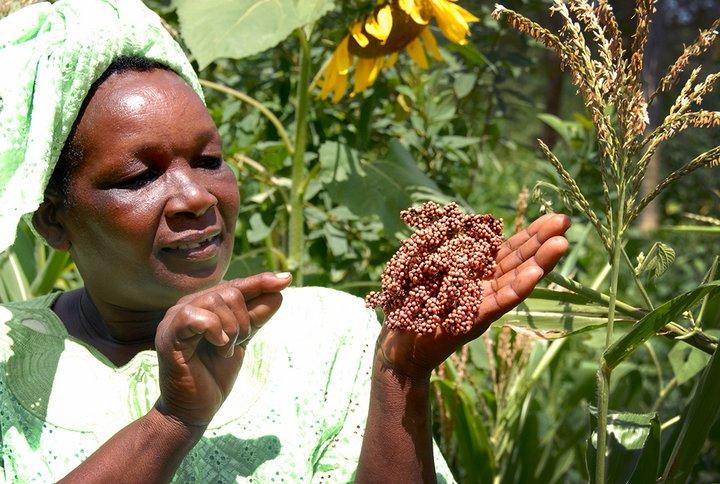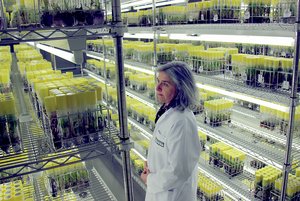Agricultural biodiversity – Use it or lose it!

In the context of the upcoming World Food Day, scientist Ehsan Dulloo explains conservation strategies for a precious resource – agricultural biodiversity. One of those strategies seems quite a paradox: the more you use it, the more you save it!
In a new blog, Bioversity International scientist Ehsan Dulloo explains the different conservation strategies for a precious resource – agricultural biodiversity. One of those strategies seems almost a paradox: the more you use it, the more you save it!
The blog highlights the main issues discussed in Chapter 5 of Mainstreaming Agrobiodiversity in Sustainable Food Systems, a new Bioversity International book that provides solid evidence that investments in agricultural biodiversity play a critical yet overlooked role in tackling global targets such as reducing poverty and malnutrition, reversing environmental degradation and combatting climate change. The book will be presented on 11 October 2017 at the 44th Committee on World Food Security in Rome, Italy.
By Ehsan Dulloo
What do you do when you have something precious that is under threat? Do you hide it away and lock it up? That could be one strategy. But there is also another one, if you are talking about the world’s precious cache of agricultural biodiversity: the more you want to conserve it, the more you need to use it! Agricultural biodiversity is not static, it evolves with time, and can provide solutions to global challenges such as climate change, food and nutrition security for current and future generations.
Why is agricultural biodiversity so precious? Farmers have bred thousands of varieties of thousands of species over thousands of years. They were not hobby gardeners breeding interesting varieties for fun, but their efforts responded to local environmental needs, pest and disease threats, and were vital to get a balanced healthy diet. This genetic diversity is now threatened by increasing homogenization in agricultural and food systems, so we need to find ways to preserve and use it.
Paradoxically, the more you use it, the more the seeds are shared and multiplied and the better it is conserved! To make the best use of agricultural biodiversity , and for it to fulfill our needs, a combination of on-farm, in situ and ex situ conservation approaches are required.
On-farm conservation – is de facto conservation considering that 60%–80% of farmers use seed from informal sources. When farmers benefit from biodiversity, they are motivated to conserve it. So the more you eat them, they more you plant them, and the more they are conserved. Benefits can take many forms – yield stability, cooking qualities, nutrition, cultural and heritage aspects, resilience, income. Research can help by increasing these benefits – so far most research dollars have gone only to a handful of eleven crops. The great thing about conserving on farm is that the crops can continue to evolve in response to local pressures and bring local solutions to local problems.
 Ex situ conservation – So, if farmers benefit from on-farm conservation, is there really a role for genebanks? Absolutely yes! First, genebanks are a back-up in case of war, or extreme natural events. For example, rebuilding seed systems in Nepal after the earthquakes in 2015, or saving Syria’s seeds in the case of the war. Second, materials in genebanks are disease-free, characterized, evaluated and there are information systems so that other scientists or breeders have easy access to find and use them. Third, there is also an ultra-long storage, the Svalbard Global Seed Vault (known as the ‘Doomsday Vault’), which aims to duplicate all genebank materials to keep them safe. The main problem with these genebanks, however, is that they can’t conserve a lot of tropical plants and trees as they have seed that perishes when kept for long periods. Also, they haven’t been very good historically at collecting wild relatives of crops, which can be sources of useful traits.
Ex situ conservation – So, if farmers benefit from on-farm conservation, is there really a role for genebanks? Absolutely yes! First, genebanks are a back-up in case of war, or extreme natural events. For example, rebuilding seed systems in Nepal after the earthquakes in 2015, or saving Syria’s seeds in the case of the war. Second, materials in genebanks are disease-free, characterized, evaluated and there are information systems so that other scientists or breeders have easy access to find and use them. Third, there is also an ultra-long storage, the Svalbard Global Seed Vault (known as the ‘Doomsday Vault’), which aims to duplicate all genebank materials to keep them safe. The main problem with these genebanks, however, is that they can’t conserve a lot of tropical plants and trees as they have seed that perishes when kept for long periods. Also, they haven’t been very good historically at collecting wild relatives of crops, which can be sources of useful traits.
 In situ conservation – What can we do about those wild relatives? For plants and animals in the wild, the situation is the opposite for plants and animals on farm, so you need a different strategy. If you eat too much of them, you run the risk of overharvesting and wiping them out. They are also often threatened by a whole set of other pressures such as invasive organisms and deforestation. These genetic resources need a completely different strategy – countries need to find out what important genetic resources they harbour, what threats they face, then prioritize their conservation in protected areas, or ‘genetic reserves’.
In situ conservation – What can we do about those wild relatives? For plants and animals in the wild, the situation is the opposite for plants and animals on farm, so you need a different strategy. If you eat too much of them, you run the risk of overharvesting and wiping them out. They are also often threatened by a whole set of other pressures such as invasive organisms and deforestation. These genetic resources need a completely different strategy – countries need to find out what important genetic resources they harbour, what threats they face, then prioritize their conservation in protected areas, or ‘genetic reserves’.
To know more about complementary conservation, combining on farm, ex situ and in situ, read more in ‘Conserving agricultural biodiversity for use in sustainable food systems’, which is Chapter 5 of Mainstreaming Agrobiodiversity in Sustainable Food Systems
____________
Photos (from top to bottom):
1. Peninah Mwangangi is a leading light in the Kyanika Womens Group in Kitui, eastern Kenya, and plays a key role in conserving local farmer landraces of a variety of crops. Here she shows some sorghum that the group is conserving. Credit: Bioversity International/ Y. Wachira
2. Banana varieties conserved in vitro at the Bioversity International Musa Germplasm Transit Centre (ITC) in Leuven, Belgium. Credit: Bioversity International/N.Capozio
3. Coffee wild relative (Coffea mauritiana) in Black River Gorges National Park, Mauritius. Credit: Bioversity International/E.Dulloo
